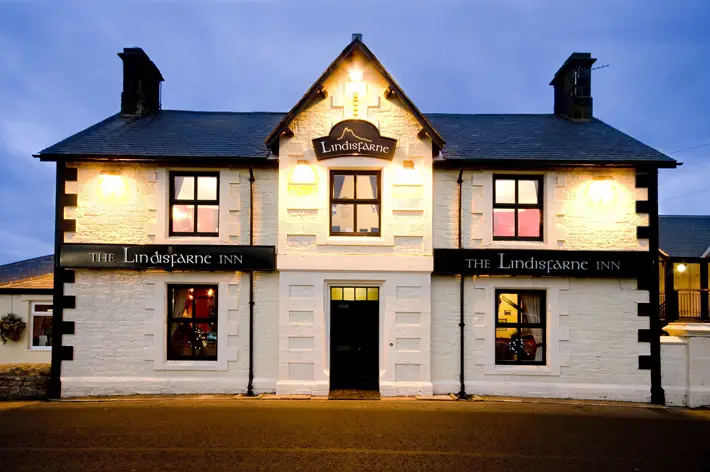Northumberland: Lindisfarne & Bamburgh Castle – Travel Review

By Clare Jenkins, July 2023
It’s undeniably one of the great British railway coastlines. North of Newcastle, passing Morpeth, Alnwick, and Alnmouth with its prettily-coloured harbour houses. Hugging the Northumberland coast, past mile upon mile of sandy beaches, past Bamburgh with its castle and then, dreamily coming into view over on the right, the Holy Island of Lindisfarne, seemingly floating in the North Sea, its Camelot-like castle rising on rock above salt marshes and mudflats.
Last time my husband and I saw it was from a CrossCountry train heading to Edinburgh in April. This time round, we drove from Sheffield to Northumberland – and quickly recalled the wise old slogan: let the train take the strain. Five hours of up-close-and-impersonal lorries, pantechnicons, dodgem drivers and Our Lady of Perpetual Roadworks later, we arrived at the Lindisfarne Inn.
Just outside the village of Beal, the inn is on the corner of the A1 (after it’s quietened down from Top Gear race to 1930s King’s England’s pace) and the link road to the island. Thanks to its position, it welcomes all manner of guests. Walkers with sturdy boots, binoculars and Nordic poles striding out on the Northumberland Coastal Walk or St Oswald’s Way. Cyclists in Lycra and helmets completing the Coast & Castle cycling route. Christian pilgrims praying before walking three miles across tidal flats to the medieval priory. And people wrapped in foil.
“Refuge huts”
Foil? They’re the unlucky few visitors who get stuck on the causeway, not realising how fast the tide comes in, and leaving it to the last minute to get off. This, despite warning notices everywhere about safe crossing times: the island is cut off from the mainland twice a day.
“We’ve had three incidents of people having to be rescued in the past six weeks,” said Lindisfarne Inn manager Zoe Butler. Sometimes they have to head for the ‘idiot boxes’, as they’re known locally – refuge huts on posts along the sand – or perch on top of their car until help arrives.
The most recent case involved a woman from Berwick who had previously lived on the island, so really should have known better.
“We always tell people to allow at least 20 minutes to get off the island,” said Zoe, “because you can get stuck in a queue. This particular woman had taken her 86-year-old mother over there for the day, and said it was when the water started coming in the footwell that she knew they were in trouble…”
Thankfully, the coastguard rescued them, wrapping the elderly mother in foil for warmth, but the car was a write-off.
“Spacious and spruce”
They’d have been well looked after at the Lindisfarne Inn, a traditional whitewashed country pub with friendly, down-to-earth staff. Its 23 bedrooms are housed in a two-floor extension out at the back. Ours was on the ground floor, with a meditative view of a brick wall and a less meditative noise of the kitchen extractor fan. But it was also spacious and spruce in muted earth colours, with a king-size Hypnos bed, plaid carpets, tea and coffee-making facilities, invaluable iron and ironing board and Spaces To Put Things. Plus a recently renovated and spotlessly clean bathroom with efficient shower and Scottish Soap Company toiletries.
Meals (ordered at the bar – no standing on ceremony here) are taken in the stone-flagged bar-cum-restaurant: again all soft plaids and tartans, warm lighting and 1980s soundtrack (think Queen’s ‘Radio Ga Ga’). The vegetarian menu is limited, so for dinner, I had my once-a-year meal of fish and chips (huge portion of battered fish, chips, mushy peas – all delicious) while my husband went for the superfood salad of chickpeas, avocado, beetroot, kale, quinoa, broccoli and pomegranate seeds, teamed with a starter portion of (rather dry) coriander falafel.
Although the restaurant was full on a Monday night, service was quick and friendly. As well as the American family nearby, assistant manager Donna Hastie said they often get Scandinavian visitors arriving off the boat at Newcastle. And, just the previous week, there had been a group of 17 pilgrims from Stonyhurst College, walking St Cuthbert’s Way from Melrose in the Scottish borders.
“Attractive”
“Because we’re the last hotel before the island, we’re the perfect little hotel for walkers and pilgrims,” said Donna. “They’ll say their prayers outside – they’re always really nice people. And we’ve got everything here – castles and beaches, the National Park and the Cheviots. We’re very spoilt.”
So how many times had she herself – living just nine miles up the A1 in Berwick-upon-Tweed – been over to Holy Island? “Er… just the once.”
And Zoe? “I’ve only been here a year and a half – and I haven’t had chance to go over yet… But I will!”
We’d been across three times before (no rank-pulling or anything), including an overnight stay at the island’s Ship Inn. A vastly different experience – peaceful, reflective, spotting terns and plovers, stargazing – from this time round.
As we’d coincided with the first week of the school holidays, traffic started driving past the hotel a good half-an-hour before the causeway’s safe crossing time of 10.45am. When two full coaches trundled past, we knew we had to get a move on. So – fortified by a breakfast of fruit salad, cereals and scrambled eggs – we joined the queue heading for the large car park just outside Lindisfarne village.
The history of the island – three miles long by one and a half miles wide, population 160 – is traced in the newly refurbished Priory Museum. It’s an attractive place showing both the religious and domestic sides of life there ever since St Aidan of Iona founded the island’s first monastery in 634AD. So there are carved medieval stones and crosses as well as coins, jugs and urinals, 16th and 17th Century olive jars and dishes, a gaming board and beads made from salmon bones.
The shop – there’s always a shop – sells books on Mindfulness and the Anglo-Saxons as well as First Steps in Old English and Ordnance Survey maps to Ancient Britain. There are Teddy Bear monks, Woolly Knight mugs, wooden crossbows, bottles of Lindisfarne mead and wassail – plus coasters proclaiming I Got Stranded at Lindisfarne. We left that one well alone.
“Massive battlements”
The weathered sandstone ruins of the subsequent 12th Century Priory are what the 650,000 annual visitors – pilgrims or not – often head to first. A stone sculpture marks the spot where its first bishop, Saint Cuthbert, was initially buried, before the Benedictine monks fled the Vikings, taking his remains with them. They were eventually laid to permanent rest in Durham cathedral.
From the village, it’s a 20-minute walk to Lindisfarne Castle. Originally a 16th Century fort, the imposing building, with its massive battlements, fell into disrepair until Edward Hudson, founder of Country Life magazine, bought it in 1901.
He commissioned his friend Edwin Lutyens – the architect of much of New Delhi – to transform the ruins into an Edwardian holiday home where he could entertain his posh London friends.
They weren’t always impressed – not least because there was no gas or electricity. In 1919, the writer Lytton Strachey wrote that it was cold, draughty and “very dark, with nowhere to sit and nothing but stone under, over, and round you, which produces a distressing effect – especially when one’s hurrying downstairs late for dinner – to slip would be instant death. No, not a comfortable place, by any means.”
“Shadowy atmosphere”
Even after its recent £3.8 million National Trust restoration, you can see what he meant. Reached by a steep cobbled path, there are uneven steps and floors inside winding through maze-like passages, under vaulted ceilings and imposing columns, past mullioned windows and numerous nooks and crannies in what you might call Grimm-baronial style.
It’s full of shadowy atmosphere, with its ornate chandeliers, dark boxed-in beds and dining-table complete with red wine stains on the linen tablecloth from overturned glasses. In the bedroom belonging to Hudson’s fiancée, the celebrated Portuguese cellist Mme Suggia, a fur stole is draped across the chair, while hairpins sit on the dressing-table, shoes tumble by the wardrobe.
From the windows, you can see the small walled garden created by Gertrude Jekyll plus, across the nature reserve, large swathes of the Northumberland coast and countryside.
Back outside, the island caters well for the visitor. As well as The Ship Inn, there’s The Crown & Anchor, a Christian retreat house, no shortage of cafes and B&Bs, galleries and souvenir shops called Lindisfarne Scriptorum and Pilgrim’s Gelato. Cuthbert must be turning in his graves [sic].
“Sumptuous furnishings”
Making our escape before the need for foil, we drove the 12 miles down the coast to Bamburgh, former Anglo-Saxon capital of Northumberland, and another rugged castle. This one, though, has a 3,000-year history – and a whole new following thanks to its role in Netflix’s The Last Kingdom, based on Bernard Cornwell’s Saxon Stories series of novels.
The castle – bought and transformed by Victorian engineer and philanthropist William George Armstrong in 1894 – now bears more resemblance to Citizen Kane’s Xanadu than to a Norman stronghold, at least in the 14 State rooms open to the public. Here, visitors can marvel at wealthy people’s taste in sumptuous furnishings and status-symbol knickknacks – fiercely decorated ceramic jars, a ‘ruby flashed octagonal goblet from Bohemia’, a glass menagerie of birds and animals, masses of Minton and Meissen, souvenir jugs decorated with verses commemorating, among other things, local lass Grace Darling (whose grave lies in the town’s St Aidan’s churchyard), a monkey orchestra made for Augustus III King of Saxony in 1853…
Elsewhere, an interactive video traces the castle’s history from Saxon times through William the Conqueror to the Wars of the Roses, various Royal inhabitants and guests, and its subsequent reinvention as a family home-plus-wedding-venue-plus-holiday-let. Armstrong’s descendants remain as keepers of the castle, which also boasts an armoury, two museums, a library-cum-snooker-room – and hypnotic views of waves tumbling onto golden sands.
The towering teak-ceilinged King’s Hall currently houses a theme-park tribute to The Last Kingdom and its follow-up film Seven Kings Must Die. Clusters of Spaniards, Italians and Indians line up to have their photos taken on The Wessex Throne or pointing in mock alarm at a life-size poster of Uhtred of Bebbanburg, as played by Alexander Dreymon.
And so my journey – as Uhtred would say – continues. Though, hopefully, not “north to blood fields…”
The Lindisfarne Inn, Beal, Berwick Upon Tweed, TD15 2PD.
Rooms from £134 per night, B&B. Look out for, too, their Walk-Inn Breaks – 2 nights B&B plus dinner the first night and a complimentary walking guide: inncollectiongroup.com
Other useful links:
english-heritage.org.uk
nationaltrust.org.uk
bamburghcastle.com
visitnorthumberland.com
Both CrossCountry and LNER run regular train services to Alnmouth and Berwick-upon-Tweed from all over the country:
hlner.co.uk
crosscountrytrains.co.uk
Top image: Visit Northumberland
















